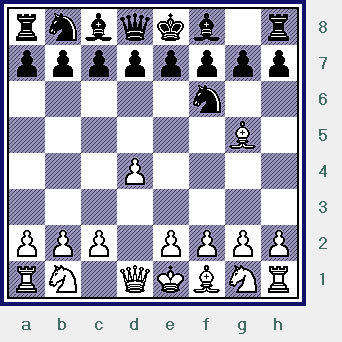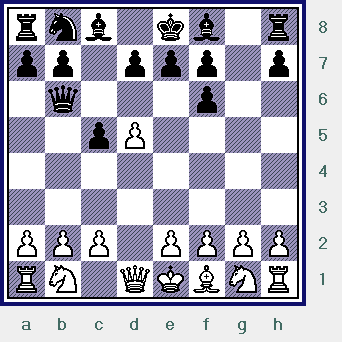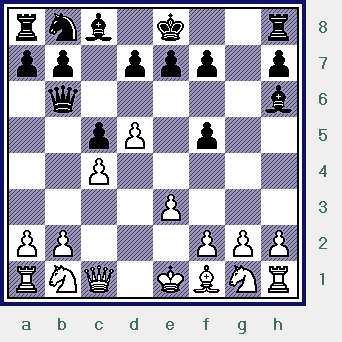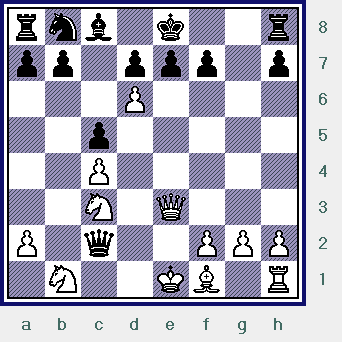All
the |
(Navigation bar
directly below.)
*******
© A.J. Goldsby, 2015.
(All rights reserved.)
****************
Click HERE
to see my
Chess Items.
****************
****************
Buy a book
from Amazon.com
(And help me out as well!)
****************
Click HERE
...
to see a list of the businesses that help to sponsor all of
my chess efforts.
Peter Wells - Alexei Shirov
Gibraltar Masters, 2006.
Click HERE to see an explanation of the symbols that I commonly use when I annotate any chess game.
Click HERE to replay this game ... on another server.
Click HERE to watch my CHESS VIDEO (on this game) on the "You Tube" server!
GM
Peter K Wells (2501) - GM Alexei Shirov (2709)
|
|
|
rnbqkb1r/pppppppp/5n2/6B1/3P4/8/PPP1PPPP/RN1QKBNR b KQkq - 0 2
The first time that I saw someone play this, I figured it was a joke of some kind, and the first time that I faced it ... I think I lost.
This unorthodox Bishop move ... can be difficult to meet, one of the main ideas is to try and degrade Black's K-side
P's.
(White captures a Knight on f6 and doubles the pawns.)
[ More common is: 2.c4 e6; with many possible openings. ]
2...c5; (center, dark-squares)
Black immediately strikes at the center, the most important part of the whole of the chess-board.
|
|
rnbqkb1r/pp1ppppp/5n2/2p3B1/3P4/8/PPP1PPPP/RN1QKBNR w KQkq c6 0 3
This cannot be bad for Black, although I think that the main line, (according to most sources); is (now) 2...Ne4.
[ After the continuation of: >/= 2...Ne4!; 3.Bf4, The Main line.
( RR3.Bh4 c5!; 4.f3 g5!?; 5.fxe4 gxh4; 6.e3 Bh6; "=/+" )
3...d5; 4.e3 c5!;
5.Nf3 Qb6; 6.Qc1 Nc6;
"=/+"
when - according to several different engines here - Black is already for choice.
One good example of this position would have to be:
Roberto Juan Jacquin (2560) - Peter Schuster (2458); [D03]
W-ch24, ICCF email / 10,06,2009. (Black won, 0-1 in 42 total moves.)
(I
could not find this game in the "Chess
Games" database of
games.)
[ For more analysis on this opening, see MCO-15, page # 508; column # 01, and all notes. ] ]
White goes ahead and doubles Black's Bishop-Pawns on the King-side.
3.Bxf6
gxf6; 4.d5, (1st element.)
For his turn, White grabs some terrain on the Queen-side here.
|
|
rnbqkb1r/pp1ppp1p/5p2/2pP4/8/8/PPP1PPPP/RN1QKBNR b KQkq - 0 4
This Pawn on d5 is an important part of the White puzzle, White's edge in space (and better Pawn structure); will help off-set Black's advantage of more open lines and the Two Bishops.
[ Prolly less than best was: RR 4.dxc5!? Na6!; "~" (equal?) and Black has no real problems. ]
4...Qb6!; "="
(counterplay)
This is an energetic Q-move. According to Fritz, Black already has (at least) equality here.
|
|
rnb1kb1r/pp1ppp1p/1q3p2/2pP4/8/8/PPP1PPPP/RN1QKBNR w KQkq - 0 5
Other logical moves for Black were 4...d6; 4...f5; and 4...Bg7.
White's next move looks to be forced.
5.Qc1
f5!;
(center, clearance)
In my mind, this move must be Black's best move here, it controls the center and prepares a double attack on b2 with the simple developing
move of ...B/f8-g7.
|
|
rnb1kb1r/pp1ppp1p/1q6/2pP1p2/8/8/PPP1PPPP/RNQ1KBNR w KQkq - 0 6
The Black foot-soldier on f5 also fulfills other functions as well, the first player's center-pawns have been restrained, clears the dark squares for his Bishop, and also prepares ...N/b8-d7-f6-e4.
White has more reasonable replies on his next move, than I care to count.
6.c4,
(center / space) {See the next diagram
here, just below.}
|
|
rnb1kb1r/pp1ppp1p/1q6/2pP1p2/2P5/8/PP2PPPP/RNQ1KBNR b KQkq c3 0 6
According to a book that I have on this opening,
("The Trompowski," by Nigel Davies, 2nd edition);
(the move of) >/=
6.g3, is the main line here.
See game # 41, on page # 83. (S. Buckley - Lalic, British League, 2004. 0-1 in 74 moves.)
(I
could not find this game in the "Chess
Games" database of
games.)
6.g3, is also one of the databases' better performing moves ... and also the top move choice for the PB.
[ Another good move choice would have been the box's top pick in this position:
>/= 6.e3,
- Fritz 12.
]
6...Bh6!?; (counter-intuitive)
Decoy!
Black offers to give up his Bishop so that the b2-square can now be conquered.
|
|
rnb1k2r/pp1ppp1p/1q5b/2pP1p2/2P5/8/PP2PPPP/RNQ1KBNR w KQkq - 0 7
However, I don't like this, it seems to me that (logically) the DSB must belong on g7-square.
[ I believe that better was:
RR 6...Bg7;
('!')
7.Nc3 d6; "=/+"
when most engines appear to choose
Black as being just a little bit better here.
- Fritz 12. ]
7.e3, (center/development/blocking)
If I understand positional chess, (square control); this move is best, as White must try to contest the dark squares.
|
|
rnb1k2r/pp1ppp1p/1q5b/2pP1p2/2P5/4P3/PP3PPP/RNQ1KBNR b KQkq - 0 7
A glance at the position reveals that the forces are close to being in balance in this position. (Maybe Black is a fuzz better here ... but that is not 100% clear, especially as you begin to work through all the different variations.)
[ Maybe inferior was: RR
7.Qc2!?
d6; 8.Nc3 Nd7; "=/+"
and all the engines are showing that Black is slightly better.
- Fritz 12 & Houdini 1.5.
]
7...f4!?, (Hmmm.)
Engine-head
chess?
This looks decent and logical ... although Black had several playable alternatives here.
(7...f4; is the first choice of many chess engines. But - in this case - its a time when the computers value material too highly and do not take into account the many problems that this move might cause. Additionally, the complications are so immense, that the chess engines literally fail to initially grasp them, in some of the lines, you have to go 5-10 moves deep before the machines can actually begin to see all of the problems that this move causes.)
|
|
rnb1k2r/pp1ppp1p/1q5b/2pP4/2P2p2/4P3/PP3PPP/RNQ1KBNR w KQkq - 0 8
In my opinion, this is just too risky for Black, (instead), with the line given below, Black gets a nice game ... with no problems at all.
[ Probably the continuation of:
RR 7...d6; 8.Nc3 Nd7;
9.Nf3 Ne5; 10.Be2 Bd7;
11.0-0 0-0-0; "~" (About equal.)
looks to be much safer than what was played in the actual game here.
]
White's next moves looks forced, otherwise, White gets an isolated Pawn on e3 for nothing in return.
(However, 8.Nc3, is the first choice of the strong chess engine, Fritz.)
8.exf4
Bxf4[];
(What else?)
If Black does not capture, he is simply down a Pawn ... for no reason at all.
|
|
rnb1k2r/pp1ppp1p/1q6/2pP4/2P2b2/8/PP3PPP/RNQ1KBNR w KQkq - 0 9
It appears that White cannot take, as, (if he does capture); then b2 will fall ... ... ...
9.Qxf4!?,
(red-light)
Fritz 12 says this is no good and it (now) shows the evaluation of "-/+" or "Black is winning."
(This would mean that - with correct play - White's last move
would have to be labeled as an error ... i.e., "9.QxP/f4?")
|
|
rnb1k2r/pp1ppp1p/1q6/2pP4/2P2Q2/8/PP3PPP/RN2KBNR b KQkq - 0 9
However, I think that this is one of those positions that could be very dangerous for Black.
(If some super-computer of the future determines that this sack is 100% sound, then the correct evaluation of
9.QxP/f4, would be
a triple exclam!)
[ According to the box, White (instead) should have played:
>/= 9.Qc3 Rg8; 10.g3
Bh6; 11.Qc2 d6; 12.Nc3 Nd7; "="
with a roughly equal game. - Fritz 12.
]
9...Qxb2[]; (Forced.)
Black finally gets to knock down the brick on b2, has this intrusion tilted the balance of power in Alexei Shirov's favor?
|
|
rnb1k2r/pp1ppp1p/8/2pP4/2P2Q2/8/Pq3PPP/RN2KBNR w KQkq - 0 10
The second player has to capture here, as he would be lost if he does not regain some of his lost material.
[ </= 9...d6??; 10.Qd2, "+-" ]
10.Ne2!, (Maybe - '!!')
According to the chess engines, this is not best, but it has got to be recorded as a decent try ...
and a great attempt at a swindle. (White's main idea is basically an attempt to trap Black's Queen.)
|
|
rnb1k2r/pp1ppp1p/8/2pP4/2P2Q2/8/Pq2NPPP/RN2KB1R b KQkq - 0 10
And the deeper you go into many of these variations, the more that the silicon "thinker" likes the White side of this contest!
[ The box "recommends" ... >/= 10.Nf3 Qxa1;
11.Bd3 d6; 12.0-0 Nd7;
"-/+" - Fritz 12.
(Fritz is actually wrong here ...)
]
10...Qxa1; (Looks OK ...)
Black goes ahead and takes the Rook, apparently he had to do so right away.
|
|
rnb1k2r/pp1ppp1p/8/2pP4/2P2Q2/8/P3NPPP/qN2KB1R w Kkq - 0 11
Instead, if Black delays, he will probably get into trouble, see the variation that I have given - just below.
[ Instead after the moves: RR
10...d6!?;
11.Nec3 Qxa1; 12.Qd2! Bf5; 13.Be2 Rg8;
(</= 13...Bxb1?; 14.0-0!, +-)
14.0-0! Bh3;
15.Re1! Bxg2;
16.f3! Bxf3+; 17.Kf2, "+/="
and White will trap the BQ. ]
White must continue onward with his plan here. (E.g., Nec3.)
11.Nec3, (Consistent.)
White plays the indicated move ...
|
|
rnb1k2r/pp1ppp1p/8/2pP4/2P2Q2/2N5/P4PPP/qN2KB1R b Kkq - 0 11
After many days of thought, and a number of hours of computer analysis ...
I have decided that I would rather be White in this game than try to defend Black's side of the board from here.
Black - with hardly no real development, and his King trapped in the corner ...
has nearly impossible problems to try and overcome from this position.
Black to move here, what should have Shirov done from here?
11...Qb2?;
(Premature.)
Black jumped the gun with this move, apparently, he did see / understand / value White's threat of d5-d6!
(If he had, he should have prevented it by playing ...d6; first - himself.)
|
|
rnb1k2r/pp1ppp1p/8/2pP4/2P2Q2/2N5/Pq3PPP/1N2KB1R w Kkq - 0 12
Now things seem to swing to being in White's favor here.
[
A significant improvement was for Black to (instead) play:
11...d6!;
12.Be2! Qb2[]; 13.Bh5 Nd7!;
"/+" - Houdini 1.5
and when the dust finally settles, Black will have a solid edge.
Editor's note: Nov. 7th, 2011: I let Houdini
run for almost two
solid hours in the final
position of this variation ...
the evaluation never changed,
Black is clearly better here. ]
12.d6!, (disruption + threats)
Now this move causes Black intense problems ... ... ...
|
|
rnb1k2r/pp1ppp1p/3P4/2p5/2P2Q2/2N5/Pq3PPP/1N2KB1R b Kkq - 0 12
Black stands on "the edge of a knife," but I don't think he is quite yet lost.
[ "Normal" developing moves will not get the job done here, viz:
</= 12.Bd3? d6;
13.0-0 Nd7; "/+" when Black is clearly better.
]
12...Qc2?; (Maybe - '??')
Who knows what induced Shirov to play this poor move, however, I cannot be overly harsh on him, Black's position was already difficult.
|
|
rnb1k2r/pp1ppp1p/3P4/2p5/2P2Q2/2N5/P1q2PPP/1N2KB1R w Kkq - 0 13
Now - please study this position (in detail) for around 3-5 minutes.
[ I think that 12...Rg8; was Black's best chance here, however,
White still has a powerful assault:
>/= 12...Rg8!; 13.Bd3!,
13...Nc6;
14.0-0, "+/" (Zugzwang?) when it is hard to even
find a decent move for Black.
**********************************************************************
Black's other try here was: 12...e6!?;
13.Bd3, (best!?)
This looks like the most effective try here for White.
(</= 13.Qf6? Qc1+; 14.Nd1 0-0; "-/+" )
13...Nc6;
14.0-0 h5;
If 14...Rg8; then 15.Qh6 is good.
15.Qf6 Rg8;
16.Bh7, ("+/-")
and White regains material,
yet the hunt for Black's King will continue from here.
**********************************************************************
Black also loses after:
12...exd6; 13.Bd3 Nc6;
The most logical.
( Or RR13...f6!?; 14.0-0! Kf7;
15.Re1 Re8; (Forced?)
There are not really many good options here for Black.
( Black also gets clobbered in
the following continuation:
15...Nc6; 16.Ne4 Kg7; (Not
much choice.)
If the BQ goes to e5, NxP/d6+ will win easily for White.
17.Qg3+! Kf8; 18.Nbc3 Ne5; 19.Qf4, "+/-"
(# in 16!?)
when Fritz goes into its "mate-finder" mode!
)
16.Rxe8 Kxe8;
17.Qxf6 Qc1+; 18.Bf1 Qe1; 19.Nd5 Na6;
20.Qg7 Qe6; 21.Nbc3 Qf7; 22.Nf6+, "+/-"
and White is winning easily. )
14.Kd1! Ne5; 15.Re1 Rf8; 16.Qf6 a6!?;
Other than "give-away" ... Black does not have any
really viable options here.
17.Nd5!, "+/-" {White is easily
winning from here.}
and Black will be mated in around 3-5 moves from here.
(Analysis line - Fritz 12 ... but checked with several other engines.) ]
Now its "White to move and win."
(What move would you play - for White - in this position?)
13.Qe3!, (Best.)
Domination. ("+/-")
White {correctly} moves his Queen to the center of the board, now GM P.
Wells holds all the aces.
|
|
rnb1k2r/pp1ppp1p/3P4/2p5/2P5/2N1Q3/P1q2PPP/1N2KB1R b Kkq - 0 13
Shirov thinks for a bit ... and then resigns. (1-0)
(Black is up an exchange, but his Queen is locked out, the board has been cut in half, and Black has no way to meet all of White's threats.)
An entertaining struggle. (Short, but lots of content!)
Copyright (c) A.J. Goldsby, 2011. All rights reserved.
[ If you need to see "the proof," here is the win, as ascertained by Fritz 12:
13.Qe3 Nc6; 14.Bd3 Qb2T;
15.0-0 b6; (Nothing better.)
This is as good - or as bad - as any of Black's other options.
16.dxe7 Bb7; This is almost forced.
(Or 16...Nd4!?; 17.Be4 d5; 18.Bxd5 Be6; 19.Bxa8 Kxe7; 20.Nd5+, "+/-" w/ an attack.)
17.Be4! Rg8; 18.Bd5 Rg6;
19.Qf4 Re6; 20.Bxe6 dxe6; 21.Qc7, ("+/-")
and White will win more material. ]
1 - 0
Editor's note: Its entirely possible that Alexei Shirov's concept was sound ... however, I don't trust it. The deeper you go into many of these lines, the more obvious it becomes that Black has tremendous difficulties defending his position, Black's King almost never finds a secure home - not in the many lines that I looked at. I have (also) noted that Shirov has had several opportunities to repeat this idea ... and has not chosen to try it a second time.
I spent about an hour, combing the Internet ... for any relevant links to this tournament, or any articles that mentioned this game.
This is what I found:
-
http://www.hindu.com/2006/01/31/stories/2006013105502200.htm (Article, The Hindu Times.)
-
http://www.oxfordtimes.co.uk/leisure/9208638.Chess__Showcase_of_British_talent/ (Article, The Oxford Times.)
-
http://www.chessgames.com/perl/chess.pl?tid=50688&pid=15809 (The CG page for this tournament.)
-
http://www.fide.com/component/content/article/4-tournaments/2130-621-georgiev-kiril--won-gibtelecom-chess-festival-2006.html (FIDE article.)
-
http://www.gibraltarchesscongress.com/ (The home-page for Gibraltar Chess.)
The analysis for this page was prepared with the excellent program, ChessBase 10.0. (My main engine was/is Fritz 12.)
The HTML was polished with several different tools and programs, (mostly FP) ... the text was checked for spelling with MS Word.
The diagrams were created with the program, Chess Captor 2.25.
|
Go ... or return ... to my Home Page for this site. Go (or return) ... to my "Annotated Games" (II) Page. Go
... or return ... to my "Best Games" Page. *******
Copyright (c)
LM A.J. Goldsby
I *******
This
page was first generated in: 2006!!! (I
never finished it.) (This page was
first posted on: Nov. 3rd, 2011.) |


















